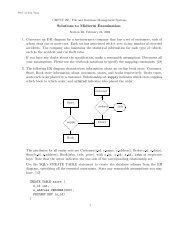CMPUT 340—Introduction to Numerical Methods - Department of ...
CMPUT 340—Introduction to Numerical Methods - Department of ...
CMPUT 340—Introduction to Numerical Methods - Department of ...
You also want an ePaper? Increase the reach of your titles
YUMPU automatically turns print PDFs into web optimized ePapers that Google loves.
Appendix: Exercise descriptions from the textbook<br />
Computer Problem 5.15. (Page 251)<br />
If an amount a is borrowed at interest rate r for n years, then the <strong>to</strong>tal amount <strong>to</strong> be repaid<br />
is given by<br />
a(1 + r) n .<br />
Yearly payments <strong>of</strong> p each would reduce this amount by<br />
n−1 ∑<br />
0<br />
p(1 + r) i = p (1 + r)n − 1<br />
.<br />
r<br />
The loan will be repaid when these two quantities are equal.<br />
(a) For a loan <strong>of</strong> a = $100, 000 and yearly payments <strong>of</strong> p = $10, 000, how long will it take<br />
<strong>to</strong> pay <strong>of</strong>f the loan if the interest rate is 6 percent, i.e., r = 0.06?<br />
(b) For a loan <strong>of</strong> a = $100, 000 and yearly payments <strong>of</strong> p = $10, 000, what interest rate r<br />
would be required for the loan <strong>to</strong> be paid <strong>of</strong>f in n = 20 years?<br />
(c) For a loan <strong>of</strong> a = $100, 000, how large must the yearly payments p be for the loan <strong>to</strong><br />
be paid <strong>of</strong>f in n = 20 years at 6 percent interest?<br />
You may use any method you like [among those you have implemented] <strong>to</strong> solve the given<br />
equation in each case. For the purpose <strong>of</strong> this problem, we will treat n as a continuous<br />
variable (i.e., it can have fractional values).<br />
Computer Problem 5.28(b). (Page 254) (Note only do Part (b).)<br />
New<strong>to</strong>n’s method can be used <strong>to</strong> compute the inverse <strong>of</strong> a nonsingular n × n matrix A. If<br />
we define the function F : IR n×n → IR n×n by<br />
F(X) = I − AX,<br />
where X is an n×n matrix, then F(X) = O precisely when X = A −1 . Because F ′ (X) = −A,<br />
New<strong>to</strong>n’s method for solving this equation has the form<br />
X k+1 = X k − [F ′ (X k )] −1 F(X k )<br />
= X k + A −1 (I − AX k ).<br />
But A −1 is what we are trying <strong>to</strong> compute, so instead we use the current approximation <strong>to</strong><br />
A −1 , namely X k . Thus, the iteration scheme takes the form<br />
X k+1 = X k + X k (I − AX k ).<br />
(b) Write a program <strong>to</strong> compute the inverse <strong>of</strong> a given input matrix A using this iteration<br />
scheme. A reasonable starting guess is <strong>to</strong> take<br />
X 0 =<br />
A ⊤<br />
‖A‖ 1 · ‖A‖ ∞<br />
.<br />
Test your program on some random matrices and compare its accuracy and efficiency<br />
with conventional methods for solving the inverse, such as LU fac<strong>to</strong>rization or Gauss-<br />
Jordan elimination.<br />
4




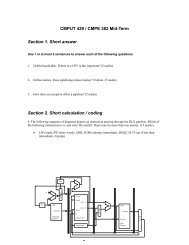

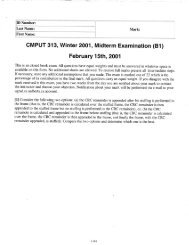
![CMPUT 313 Final Exam [Harms] April 26, 2000 g L (Ilosed Book](https://img.yumpu.com/45617471/1/190x245/cmput-313-final-exam-harms-april-26-2000-g-l-ilosed-book.jpg?quality=85)
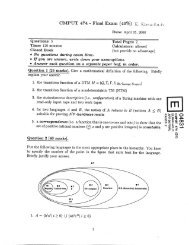
![CMPUT 379 Midterm Exam [Harms]](https://img.yumpu.com/44750568/1/190x245/cmput-379-midterm-exam-harms.jpg?quality=85)



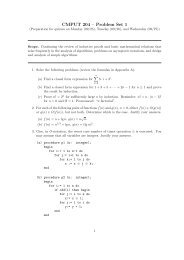

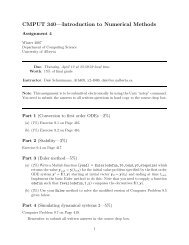
![CMPUT 272 Midterm [B2 -- Harms]](https://img.yumpu.com/36401258/1/190x245/cmput-272-midterm-b2-harms.jpg?quality=85)
